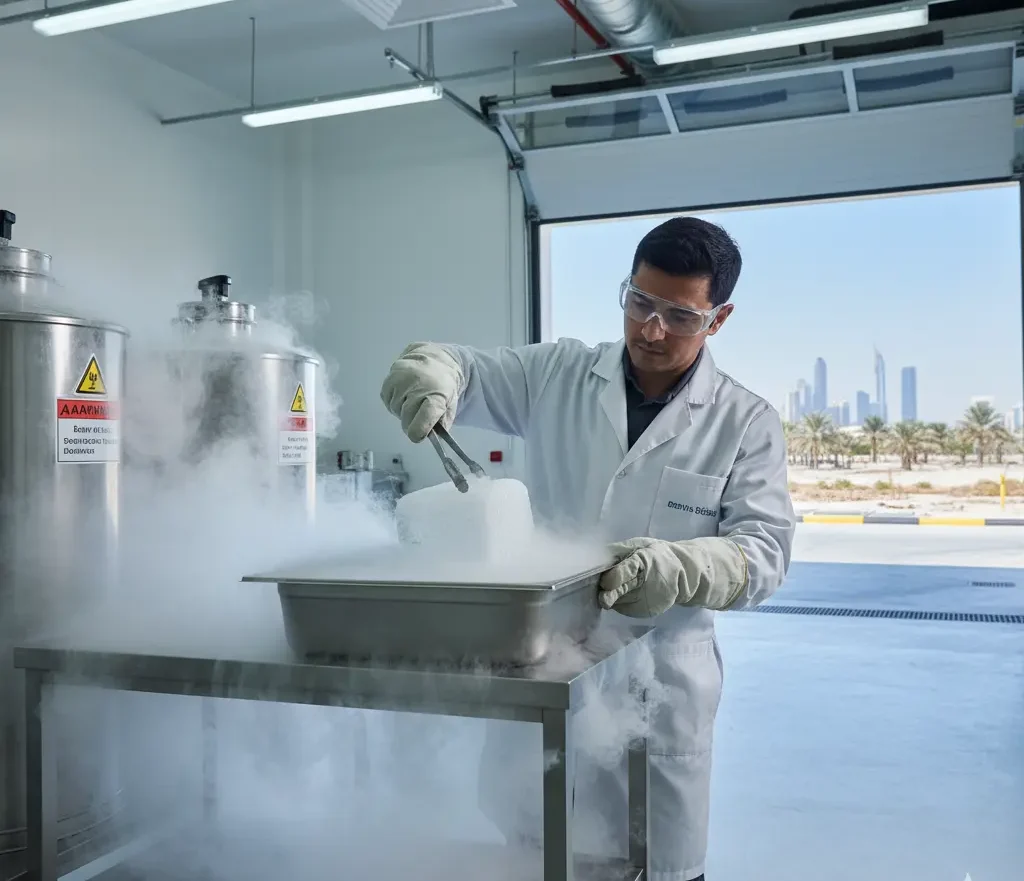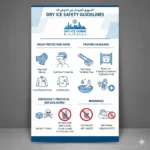Dry ice is a fascinating and incredibly useful substance, widely employed in everything from dramatic special effects at events to critical temperature control in medical and food industries. It’s solid carbon dioxide (CO2), and unlike regular ice, it doesn’t melt into a liquid; it “sublimates” directly into a gas. This gas is what many refer to as “dry ice fumes.” A common question that arises is: Are dry ice fumes safe?
The short answer is: Dry ice fumes (which are actually concentrated CO2 gas) are safe when handled correctly and with adequate ventilation. However, improper handling or exposure to high concentrations of CO2 can pose health risks. As the leading dry ice supplier in Dubai, Dry Ice Dubai is committed to ensuring our customers understand how to use this powerful substance safely and effectively. This guide will walk you through everything you need to know about dry ice fumes and best safety practices.
What Exactly Are "Dry Ice Fumes"? Understanding Sublimation
When dry ice sublimates, it changes from a solid directly into carbon dioxide (CO2) gas, bypassing the liquid phase. The visible “fumes” or “smoke” you see rising from dry ice are not pure carbon dioxide. Instead, they are a mixture of CO2 gas and condensed water vapor from the surrounding air. The extremely cold CO2 causes the moisture in the air to condense, creating that characteristic thick, white fog.
While the fog itself isn’t toxic, the invisible carbon dioxide gas it contains is what matters for safety. CO2 is naturally present in the air we breathe, but in much lower concentrations.
The Science Behind the Safety: Why CO2 Concentration Matters
Carbon dioxide is an odorless, colorless gas, making it difficult to detect without proper equipment. Our bodies produce CO2 constantly as a waste product, and we exhale it with every breath. However, when the concentration of CO2 in the air around us increases significantly, it can displace oxygen, leading to adverse health effects.
Here’s a breakdown of how different CO2 concentrations can affect you:
- Normal Outdoor Air: ~0.04% (400 ppm) CO2
- Typical Indoor Air: ~0.04% – 0.1% (400-1,000 ppm) CO2
- Slightly Elevated Levels (above 1% / 10,000 ppm): Can cause drowsiness, headaches, and increased heart rate.
- High Levels (above 5% / 50,000 ppm): Can lead to dizziness, confusion, rapid breathing, and an increased risk of unconsciousness or suffocation due to oxygen deprivation.
- Very High Levels (above 10% / 100,000 ppm): Extremely dangerous and can be fatal very quickly.
Since dry ice sublimates rapidly, especially in unventilated or confined spaces, it can quickly raise CO2 concentrations to dangerous levels.
Key Safety Measures for Handling Dry Ice
To ensure the safety of everyone around dry ice, adherence to strict handling protocols is crucial.
Ensure Proper Ventilation:
- Always use dry ice in well-ventilated areas. This is the most critical safety measure. Good airflow prevents CO2 from accumulating to harmful concentrations.
- Avoid using dry ice in small, enclosed spaces like closets, cars (without windows open), or unventilated basements.
- When transporting dry ice in a vehicle, ensure windows are open, or if possible, transport it in the trunk (away from the passenger compartment) with some ventilation.
- For large quantities or extended use in indoor settings, consider using CO2 monitors to alert you to unsafe levels.
Wear Personal Protective Equipment (PPE):
- Insulated Gloves: Dry ice is extremely cold (-78.5°C or -109.3°F) and can cause severe frostbite upon direct contact with skin. Always wear heavy-duty insulated gloves (e.g., cryogenic gloves) when handling dry ice. Standard kitchen gloves are not sufficient.
- Safety Glasses/Goggles: Protect your eyes from any small fragments or particles that may chip off.
- Long Sleeves and Pants: Cover exposed skin to prevent accidental contact.
Proper Storage:
- Use Insulated Containers: Store dry ice in a well-insulated container, such as a high-quality cooler. Do NOT use an airtight container, as the sublimating CO2 gas will build pressure and could cause the container to explode.
- Never Store in a Freezer: Regular freezers are not cold enough to keep dry ice solid and are airtight, creating a hazardous pressure buildup.
- Keep Out of Reach: Store dry ice in a secure location, out of reach of children and pets.
- Away from Living Spaces: Ideally, store dry ice in a garage, shed, or another area with good airflow, away from sleeping or confined living spaces.
Safe Transportation:
- Never transport dry ice in the passenger compartment of a vehicle unless it is extremely well-ventilated. Ideally, place it in the trunk or truck bed of a vehicle, ensuring there’s a barrier to prevent gas from entering the main cabin.
- Ensure Airflow: Crack windows or activate fresh air ventilation in your vehicle.
- Limit Transport Time: Minimize the duration of dry ice transport whenever possible.
Responsible Disposal:
- Allow to Sublimate in a Well-Ventilated Area: Place any leftover dry ice in a well-ventilated location where it can sublimate safely (e.g., outdoors or in a utility room with good airflow).
- Never Dispose in Drains or Toilets: The extreme cold can damage plumbing.
- Never Leave Unattended: Do not leave dry ice in public areas where people or animals might come into contact with it.
Recognizing the Warning Signs of CO2 Exposure
Even with precautions, it’s essential to be aware of the symptoms of CO2 exposure:
- Headache
- Dizziness or lightheadedness
- Nausea
- Rapid breathing or shortness of breath
- Confusion or difficulty concentrating
- Unconsciousness (in severe cases)
If you experience any of these symptoms while using dry ice, immediately move to fresh air. If symptoms persist or worsen, seek medical attention.
When to Call a Professional: Dry Ice Dubai is Here to Help
For specialized applications, large quantities, or if you’re ever unsure about safe handling, it’s always best to consult with experts. Dry Ice Dubai provides:
- Certified Food & Medical Grade Dry Ice: Ensuring the highest purity and safety standards for critical uses.
- Professional Dry Ice Blasting Services: Our trained technicians use specialized equipment to perform industrial cleaning safely and efficiently.
- Expert Advice: Our team is always ready to provide guidance on the correct handling, storage, and application of dry ice for your specific needs.
- Reliable Delivery: Fast, safe, and efficient delivery across Dubai and the UAE, ensuring your dry ice arrives securely packaged and ready for use.
Don’t compromise on safety. Partner with Dry Ice Dubai for all your dry ice and cryogenic needs.
Conclusion: Prioritizing Safety for Effective Dry Ice Use
Dry ice is an invaluable resource, but its unique properties demand respect and adherence to safety guidelines. By understanding that “dry ice fumes” are primarily concentrated CO2 gas, and by prioritizing ventilation, proper PPE, and safe storage, you can harness its power without risk. Dry Ice Dubai is dedicated to not only supplying the highest quality dry ice in the UAE but also to empowering our community with the knowledge to use it responsibly.
Frequently Asked Questions (FAQs)
What are dry ice "fumes" composed of?
Dry ice “fumes” are actually carbon dioxide (CO2) gas mixed with condensed water vapor from the air, creating the visible white fog. The primary concern for safety is the invisible CO2 gas.
Is it safe to be in the same room as dry ice?
Yes, as long as the room is well-ventilated. In a confined or unventilated space, the sublimating CO2 can rapidly build up to unsafe concentrations, displacing oxygen.
Can dry ice cause suffocation?
Yes, in poorly ventilated or enclosed spaces, the accumulation of CO2 gas from dry ice sublimation can displace oxygen, leading to oxygen deprivation and potential suffocation.
What happens if I touch dry ice without gloves?
Direct contact with dry ice can cause severe frostbite due to its extremely low temperature (-78.5°C or -109.3°F). Always wear insulated gloves.
How should I store dry ice safely?
Store dry ice in a well-insulated, non-airtight container (like a cooler) in a well-ventilated area. Never store it in an airtight container or a regular freezer.
What are the signs of too much CO2 exposure?
Symptoms include headache, dizziness, nausea, rapid breathing, confusion, and in severe cases, unconsciousness. If experienced, immediately move to fresh air.
Can I transport dry ice in my car?
Yes, but with extreme caution. Place it in the trunk or truck bed, if possible. Always ensure the vehicle is well-ventilated by opening windows or using the fresh air setting to prevent CO2 buildup in the passenger cabin.






